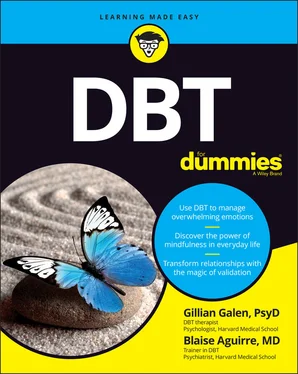In other words, it may be factually incorrect that that person isn’t loved, and yet the emotion that they experience is real and is not readily dispelled simply by someone saying that they shouldn’t feel it.
 Invalidation occurs when you tell another person that it doesn’t make sense that they feel a certain way. Telling a person not to feel the way they feel rarely leads them to change their emotional experience, and it also tells them that the way they feel is out of proportion to whatever event elicited the emotion.
Invalidation occurs when you tell another person that it doesn’t make sense that they feel a certain way. Telling a person not to feel the way they feel rarely leads them to change their emotional experience, and it also tells them that the way they feel is out of proportion to whatever event elicited the emotion.
Reinforcement of strong emotions
Another feature of the invalidating environment is that it can reinforce displays of strong emotions. Reinforcement is any consequence that comes after a behavior that increases the likelihood that the behavior will either increase or be maintained at current levels.
 Another way to think about a reinforcer is that it’s like a reward. So, if a person is ignored when they are distressed at low levels of emotional expression but attended to when they have big emotions, and if what they want is other people’s attention, then it makes sense that high emotions will show up more frequently.
Another way to think about a reinforcer is that it’s like a reward. So, if a person is ignored when they are distressed at low levels of emotional expression but attended to when they have big emotions, and if what they want is other people’s attention, then it makes sense that high emotions will show up more frequently.
Another feature of the invalidating environment is that when a person is told that their displays of emotional upset are unacceptable, unwarranted, or unjustified, they often begin to feel shame for having behaved in the way they did or even for having any emotions at all. The problem with this is that shaming someone doesn’t teach them what to do when they are feeling strong emotions, and as such, they don’t learn what to do the next time strong emotions show up. It also prevents a person from learning how to accurately name and label their emotions.
Imagine that a person could not name and label vegetables and that they were told to go buy vegetables but instead came back with bread and milk and were then ridiculed for not having bought vegetables. Shaming this person wouldn’t teach them what they had to do, and long-term shame can cause significant psychological damage. In such situations, what the person actually learns is to oscillate between going to great lengths to prevent the display of big emotions for fear of being punished and then having big emotional eruptions without knowing how to manage them.
Dismissal of problems and reactions
Finally, the invalidating environment tells emotionally sensitive people that their problems are easy to solve. “Oh, just calm down. That’s what I do,” a parent might tell an emotionally sensitive adolescent. Whereas this may be easy for the parent, it might not be for the child. When people who are emotionally sensitive and, according to the biosocial theory, have a biologically hard-wired temperament or disposition toward being emotionally vulnerable, they have a relatively low threshold for responding to factors in the environment that are emotionally arousing.
It would be like a child having been born with a peanut allergy and being sensitive to peanuts in the environment. Telling the child not to have a reaction to peanuts would ignore what the child’s biology is. Similarly, telling a person with emotional sensitivity not to have the reaction they are having ignores their neurobiology.
 When other people ignore, dismiss, or punish emotionally sensitive people’s reaction or oversimplify the ease of coping or solving the problem they are experiencing, over time that person is left without adaptive coping mechanisms. Instead, they turn to quickly executable and often self-destructive ways of coping, including behaviors such as self-harm and drug use.
When other people ignore, dismiss, or punish emotionally sensitive people’s reaction or oversimplify the ease of coping or solving the problem they are experiencing, over time that person is left without adaptive coping mechanisms. Instead, they turn to quickly executable and often self-destructive ways of coping, including behaviors such as self-harm and drug use.
Focusing on the Functions and Goals of a Comprehensive Treatment
Based on the conceptualization of disorders characterized by difficulties in emotion (see the earlier section “ Beginning with the Biosocial Theory”), DBT specifically focuses on helping people regulate their emotions in more adaptive ways. And so, DBT includes many behavioral skills that specifically aim to teach patients how to recognize, understand, label, and regulate their emotions.
A comprehensive treatment is needed to help people who are emotionally sensitive. For any treatment to be comprehensive, it must address five essential functions, and DBT is no different. A comprehensive treatment must accomplish the tasks in the following sections.
Motivating the patient and the therapist
A comprehensive treatment motivates a patient to participate in and complete the treatment, and various strategies are used to keep both the patient and the therapist in the therapy. Motivation comes from understanding the person’s goals while at the same time identifying their relevant strengths and relative weaknesses. The therapist works to ensure that they themselves are clear as to what the patient’s goals are, that they have explained how DBT can help the person attain their goals, and then that they and the patient can collaborate in the process. Motivation goes beyond just the patient. It also targets the therapist’s motivation, particularly when then are finding the work to be frustrating. We review motivational strategies in greater depth in Chapter 19.
Teaching the patient new coping mechanisms
A comprehensive treatment teaches the patient new ways of coping with life’s challenges or enhances a person’s existing capabilities. In DBT, therapists hold the assumption that people who are struggling aren’t doing so out of choice but rather that they lack, or need to improve, several important life skills, including the following:
The ability to regulate emotions
The ability to pay careful and accurate attention to the experience of the present moment
The ability to tolerate difficult moments
The ability to effectively negotiate relationships
 The idea is that maladaptive or ineffective behaviors are replaced by healthier, more effective, and longer-lasting ways of managing difficult moments. The teaching of these skills usually takes place in a weekly skills group session, which usually has up to ten patients and two co-leaders. The group generally lasts 90 minutes and has a didactic component where skills are taught, and homework is assigned and is reviewed in the next skills group. We cover skills therapy later in this chapter.
The idea is that maladaptive or ineffective behaviors are replaced by healthier, more effective, and longer-lasting ways of managing difficult moments. The teaching of these skills usually takes place in a weekly skills group session, which usually has up to ten patients and two co-leaders. The group generally lasts 90 minutes and has a didactic component where skills are taught, and homework is assigned and is reviewed in the next skills group. We cover skills therapy later in this chapter.
Incorporating new skills into the patient’s daily life
Comprehensive treatment generalizes the new skills and new ways of coping to a patient’s daily life. If the skills learned in therapy sessions don’t apply or transfer to patients’ daily lives, then it would be difficult to say that therapy was successful. This function is accomplished in two ways:
In the skills training group, the therapist provides and then reviews the weekly homework assignments given in the skills group.
The patient is allowed to contact the therapist between sessions so that they can get help directly from the therapist in situations where the patient doesn’t know what to do or how to apply the skills. (Find out more about phone coaching later in this chapter.)
Читать дальше

 Invalidation occurs when you tell another person that it doesn’t make sense that they feel a certain way. Telling a person not to feel the way they feel rarely leads them to change their emotional experience, and it also tells them that the way they feel is out of proportion to whatever event elicited the emotion.
Invalidation occurs when you tell another person that it doesn’t make sense that they feel a certain way. Telling a person not to feel the way they feel rarely leads them to change their emotional experience, and it also tells them that the way they feel is out of proportion to whatever event elicited the emotion. Another way to think about a reinforcer is that it’s like a reward. So, if a person is ignored when they are distressed at low levels of emotional expression but attended to when they have big emotions, and if what they want is other people’s attention, then it makes sense that high emotions will show up more frequently.
Another way to think about a reinforcer is that it’s like a reward. So, if a person is ignored when they are distressed at low levels of emotional expression but attended to when they have big emotions, and if what they want is other people’s attention, then it makes sense that high emotions will show up more frequently.










